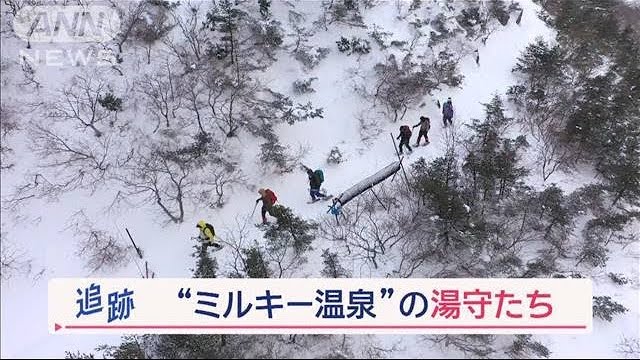FUKUSHIMA, Feb 11 (News On Japan) - In the shadow of Mount Adatara in Nihonmatsu City, Fukushima Prefecture, lies the renowned Take Hot Springs, celebrated for its "Milky Day" - a phenomenon occurring just once a week when the waters turn a cloudy white. Despite facing the severest cold wave, we followed the journey of the dedicated hot spring craftsmen, the guardians of these thermal waters, as they ventured into the snowy mountains to maintain the spring's flow.

The Weekly Delight of Milky Hot Springs
Take Hot Springs, with a history stretching over 1200 years, is nestled at the foot of Mount Adatara in Nihonmatsu City, Fukushima. Its water, an "acidic spring," is famed for its skin-smoothing properties, dubbing it the "hot spring for beauty."
This hot spring resort has clinched the top spot in the history and culture category of the "Hot Springs General Election," thanks to its unique charm: the transformation of its clear waters into a milky white, an occurrence that can be enjoyed just once a week.
Visitors from Fukushima City, in their 70s and 60s, expressed their anticipation for this special "Milky Day," having heard about the days when the water turns white.
For about four years now, Take Hot Springs has been promoting this special day as "Milky Day."
Akiko Nibei, the proprietress of the inn "Hanakanzashi," explained that while the locals take the weekly whitening of the springs for granted, visitors find it extraordinary and precious, drawing many to experience "Milky Day."
"Hanakanzashi" offers a day-trip hot spring plan that includes a kaiseki meal, enhancing the experience.
A Five-Hour Return Trip for Harsh Pipe Cleaning
Once a week, a group of hot spring guardians, ranging from 28 to 73 years old, trek into the mountains to deliver the milky hot springs to the town. Despite the season's coldest wave, they spend about five hours cleaning the spring's pathways.
Kiyoharu Takeda (72) explained that the spring's components solidify and stick to the inside of the pipes, necessitating their removal.
The spring water flows about 8 kilometers from a source near the 1500-meter elevation of Mount Adatara to the hot spring town. Without regular cleaning, the spring components would solidify mid-way, causing blockages.
This mission extended to the "source" itself.
After uncovering an inspection port buried under snow, they insert a "special brush" to clean inside the pipes.
First, they let a rope attached to the brush flow through the port, pulling it from another port to scrape off the accumulated spring components.
As they worked, the water inside the port turned milky white, rich with "yunohana," the mineral deposits that define "milky hot springs."
Led by Takeda, a veteran of 22 years, these guardians embody a strong sense of duty, a sentiment that was particularly evident during the Great East Japan Earthquake.
Takeda recalls climbing the mountain alone the morning after the earthquake to check on the springs, prioritizing the community's treasure over his own home.
The guardians, whose lineage stretches back approximately 200 years, are committed to protecting these springs regardless of the challenges, including the most severe snowstorms.
The inspection of about 20 ports near the source is fraught with difficulties, especially with winds reaching speeds of 13 meters per second and higher on the mountain.
Working at an elevation of 1500 meters is perilous, not just because of the blizzards but also due to hidden dangers beneath the snow, such as cavities formed by the heat of the springs.
Last February, they experienced a sudden snow collapse, highlighting the life-threatening risks involved. Moreover, the danger of inhaling lethal hydrogen sulfide gas necessitates careful consideration of wind conditions during their work.
On this occasion, finding a supposed inspection port proved challenging for team leader Takeda, relying on decades of experience to locate it amidst snowdrifts.
After about 15 minutes of digging, they finally uncovered the port.
An hour and a half into the task, the guardians' endurance was tested by the cold and wind as they worked to ensure the flow of the milky hot springs to the town.
This special water, rich in yunohana, takes 40 minutes to reach the hot spring town, a luxurious experience available just once a week.
Visitors from Fukushima and Koriyama praised the "exhilarating" experience provided by the guardians, marveling at the beauty and tranquility of the milky springs.
Under Takeda's leadership, the guardians continue their efforts to preserve this local treasure. With younger guardians joining their ranks, there's a renewed sense of hope for the future of this cherished tradition.
At 73, Takeda, who ran a guesthouse until last year, reflects on the changing fortunes of the hot spring town and the enduring commitment to protect its legacy, a testament to the guardians' dedication to preserving their community's heart.
Source: ANN














